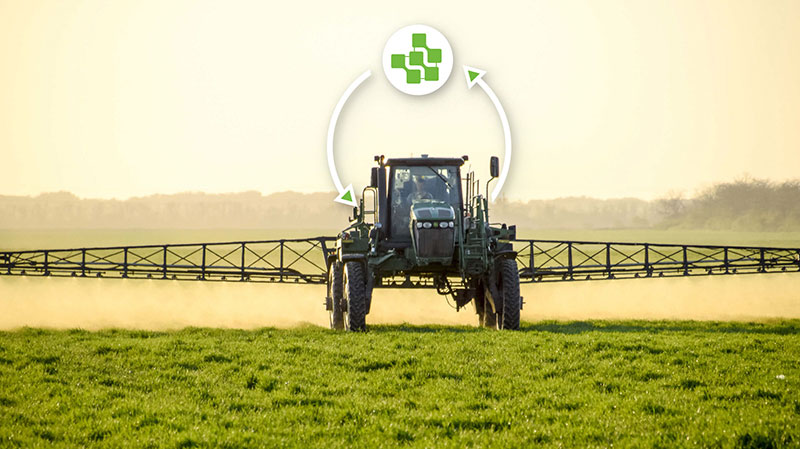Southern States: Always Ag Authentic

Southern States Cooperative is ranked No. 9 on the CropLife 100 list of largest U.S. ag retailers. Pictured is the co-op’s Richmond, VA, corporate headquarters.
If people were to judge a book by its cover when visiting Southern States Cooperative’s (SSC) Richmond, VA, corporate headquarters, they would likely come away with a pretty sterile first impression of the CropLife 100 No. 9 ranked retailer.
Operating its $2 billion in annual sales, farmer-owned cooperative out of a nondescript seven story office building in a corporate development just off I-64, what makes the offices at 6606 West Broad Street special isn’t the fancy lobby that greets visitors or the carpeted and well-appointed executive floor.
You see, much like its 70 member cooperative locations dotting the map throughout the Mid-Atlantic region, what makes a visit to SSC’s headquarters worthwhile is the same thing that makes doing business with the cooperative special: the people.
“We’ve surveyed our customers a lot over the last five or six years, and the number one reason when you ask why they love Southern States, it always comes back to the people,” says Steve Patterson, SVP corporate marketing and communications, during my first day in Richmond. “They’ll mention the products and say they like them too, but it’s the people that they like the most. We’ve got good people and that’s easily half the battle.”
Fresh Leadership
One of those “good people” Patterson alludes to is still getting his feet under him in Richmond as the company’s relatively new president and CEO.
Jeffrey Stroburg — a native Iowan that came out of retirement to lead SSC after holding the same position with West Central Cooperative for 16 years — has been on the job for a little over four months now, and he says that how SSC has structured its business units (SSC actively markets to everyone from the professional row-crop farmer to the weekend hobbyist growing tomatoes in the backyard) is one of the more unique approaches he’s encountered.
“Somebody that has a three-acre truck patch or garden patch will come into one of our stores and get a gallon of Roundup off the shelf and the lady at the counter will check him out,” explains Stroburg. “And the commercial producer that’s got 10,000 acres, he’ll go into the same store and get a gallon of Roundup off the shelf too, so it’s not like we are truly segmented, but we do have different go-to-market approaches.
“Now if that 10,000-acre grower wants us to meet him in his office attached to his machine shed, we’ve got the people that will do that, and they’ll bring out the computers and lay everything out for him, or he can come into one of our stores and buy a gallon of Roundup and get on with his day if that’s what he wants.”

Steve Patterson, VP marketing and communications, shows a map of Southern States’ operating territory.
Says Patterson of SSC’s three-pronged go-to-market approach (which consists of what SSC refers to as its core-ag producers, or large growers, along with the company’s consumer-facing store front division, known internally as Rural America, as well as its more-traditional wholesale inputs business: “We have those three different growth strategies, and trying to remain relevant for the dealers, the producers and that Rural America customer is very important because if you don’t remain relevant they’re going to go someplace else. When we talk about these three strategies we sometimes internally draw clean lines between the three segments, but they’re really not that clean.”
Another big difference from Stroburg’s past experiences out in Iowa is the diversity of crops throughout SSC’s territory. On any given day the company could be producing a Webinar for its high intensity wheat management program for growers throughout its southernmost territories such as south or mid-Georgia, whereas the next day staying relevant to vegetable growers in Eastern North Carolina could be the focus of a different internal training effort.
“What I see that’s different from what I’m familiar with in Iowa is the diversity,” he explains. “I think it’s driven largely by that need to — if you’ve got a smaller acreage — you’re going to be looking for other alternative cash-income opportunities. Whereas in Iowa, it was either corn or soybeans and you either had corn on the north side of the road or beans on the north side of the road. That was the diversity. So, this part of the world, it is a bit different than what I’m used to.”
Patterson points to the turn of the century AgWay acquisition as one of the humps SSC has gotten over in the past.
“It was tough for us to go up to AgWay in the northeast,” Patterson explains. “You don’t assimilate a Northeastern cooperative easily into a Mid-Atlantic and southeast cooperative. Our business up there is about $120 million (annually) and it’s mostly on the feed and farm supply side. There is a culture up there — to their credit, AgWay had a lot of great people and their own culture and Southern States, and we have ours. The one thing that was over arching was agriculture and the passion for growing things, and that whole ag authenticity thing stretched overall and it has worked, but you’re merging some cultures there and it’s not always easy.”
The same could be said, Patterson adds, of the GoldKist addition in the southeast.
“Great people, similar cultures, but still change and the challenges of assimilating the three cooperatives wasn’t easy to overcome,” he recalls.
The Search For Talent
Of course, with an operating territory stretching from the Everglades into Maine/Vermont dairy country, keeping its talent pool stocked with top-notch employees remains yet another daily challenge for the 200,000 member-plus cooperative.
“That is not something that we should not be worried about,” replies Stroburg when asked whether the much-publicized age gap in agriculture worries him. “You know we should worry about that, but there is a solution and that solution is to keep bringing in new talented young people. I think that is a concern for everybody in the industry, but there’s an easy solution. Bring in new talent.”
Patterson agrees — albeit with the caveat that SSC must remain true to its roots.
“It’s such a home town business, it really is,” he says of agriculture in general. “Some of our most successful locations are places where the store manager and the sales person are native to that area, and they already know a lot of the customers and they all trust each other. They’ve built those relationships over time, and it’s hard to duplicate that across a broad area.”
Yet, if there’s one thing I learned and will take away from SSC over my nearly two days spent traversing its hallways, it’s that it is not particularly difficult to duplicate that which is authentic and true and comes from a good place.
“There’s a unique character out there that likes to deal with a company like Southern States, and we always say it’s those people that have that rural DNA in their blood — they like rural America and they like growing things,” says Patterson prior to wrapping up our visit and sending me on my way back to Ohio. “If it has the word ‘farmer’ in it, we want to be a part of it. Regardless of farm size or any of that, that’s really who we are. It all goes back to that Agricultural Authenticity.”






